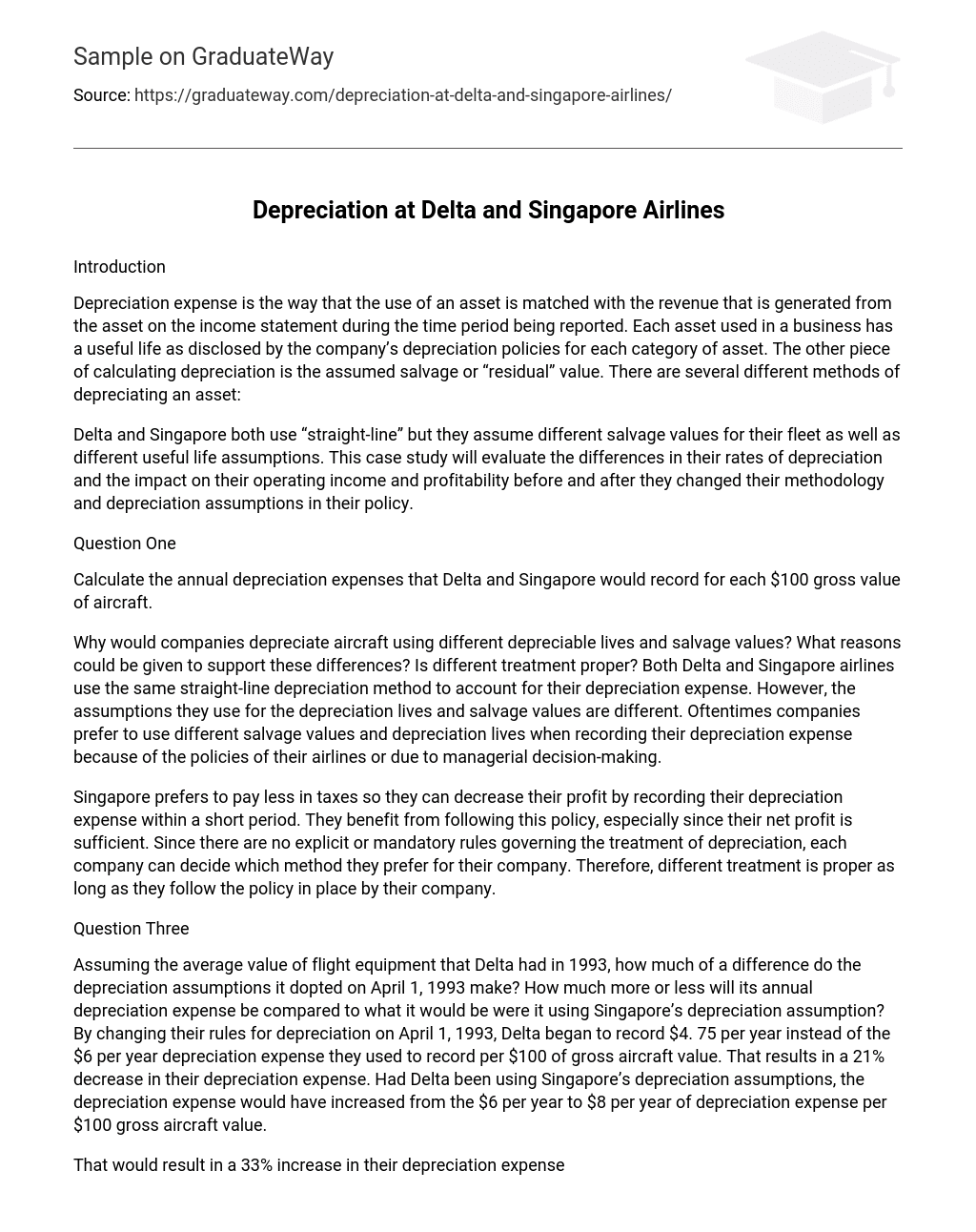Introduction
Depreciation expense is the matching of an asset’s use with the revenue it generates on the income statement. This is done during the reported time period. Every business asset has a disclosed useful life according to the company’s depreciation policies for each asset category. The calculation of depreciation also includes the assumed salvage or “residual” value. There are various methods for depreciating an asset.
Both Delta and Singapore use the “straight-line” method for depreciation, but they have different assumptions for the salvage value of their fleet and the useful life. In this case study, we will analyze the differences in their depreciation rates and the effect on their operating income and profitability before and after they modified their policy regarding methodology and depreciation assumptions.
Question One
Delta and Singapore would record annual depreciation expenses of $100 gross value of aircraft.
Companies may choose to depreciate aircraft using different depreciable lives and salvage values. The rationale behind these differences can be justified for various reasons. The use of different treatment is considered appropriate by Delta and Singapore airlines, both of whom employ the straight-line depreciation method for their depreciation expense. However, they differ in the assumptions made regarding the depreciation lives and salvage values. Often, companies opt for varying salvage values and depreciation lives due to their respective airline policies or managerial decision-making.
Singapore prioritizes reducing taxes by expensing their depreciation within a shorter timeframe, aiming to decrease their profit. This strategy proves advantageous, particularly given their sufficient net profit. As there are no strict regulations dictating the treatment of depreciation, each company has the freedom to choose their preferred methodology. Consequently, varying approaches are acceptable as long as they align with the company’s established policy.
Question Three
In 1993, Delta adopted new depreciation assumptions for flight equipment. This change resulted in a 21% decrease in their annual depreciation expense from $6 per $100 of gross aircraft value to $4.75 per year. If Delta had used Singapore’s depreciation assumptions, their annual depreciation expense would have increased from $6 to $8 per year per $100 of gross aircraft value.
The increase in depreciation expense for 1993 would be 33%, which amounts to $226 million more compared to the previous expense of $679 million, resulting in a total expense of $905 million.
Question Four
Singapore Airlines has different depreciation assumptions compared to Delta, and this has implications for its overall strategy. The airline maintains a young average fleet age of 5.1 years. Previously, Singapore depreciated their aircraft over 8 years with a salvage value of 10%, but from 1989 onwards, they increased it to 10 years with a salvage value of 20%.
The average depreciation rate per $100 for Singapore Airlines was $11.25 prior to this change and $8.00 after, compared with Delta’s $6.00. The company is majority-owned by the Singapore government, but did not receive any subsidy from the government. Its stock is, however, followed by over 20 investment analysts worldwide. In 1993, their net profit dropped from $922 to $741 million in Singapore dollars as depreciation expense as a percent of total operating expenses had grown from 14.8% to 15.8% in one year. Staff bonuses were cut from 3.4 months of pay to .5 months of pay in one year.
Their profitability was being hindered by two main issues. Firstly, their strategy was not aligned with their utilization rate, which had decreased from 78.9% in 1989 to only 71.3%. Secondly, they should have focused on the percentage of operating expense spent on depreciation much earlier. By addressing these issues, they could have minimized the decline in net profits, which had been continuously decreasing over the past five years. In order to fund their aggressive capital expansion program of $2 billion annually, they needed to find ways to increase net income and cash flow.
To decrease costs and boost net income, a modification was necessary in how their fleet was being depreciated. If they decided to keep acquiring new aircraft, they would either have to devise a new depreciation method or face increased depreciation expenses due to the addition of newer planes to the existing fleet’s depreciation base.
Question Five
Do the average age differences of Delta and Singapore’s aircraft fleets affect their depreciation expenses? If yes, by how much?
Delta’s average aircraft age in 1993 was 8.8 years, considered young compared to industry standards. However, Singapore had an even younger average age at 5.1 years. The calculation of total depreciation does not consider the age of the aircraft, as it relies on the formula for depreciation cost per $100 of gross value. This formula factors in useful life and salvage value to determine the depreciation rate. The remaining depreciation for each fleet will depend on the number of older planes that have already been fully depreciated, rather than the average annual amount.
Conclusion
Modifying the corporate depreciation policy can greatly affect the company’s net income. Regardless of the industry, be it airline or manufacturing, maintaining earnings is crucial for shareholders, management, and employees with bonus plans. A substantial rise in assets can result in higher depreciation expenses, causing a decline from the previous year’s net income to a net loss in the following year.





